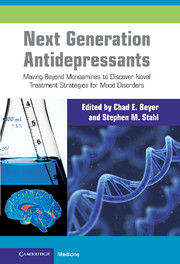 Next Generation Antidepressants
Next Generation Antidepressants using imaging technologies in biomarker research
Published online by Cambridge University Press: 19 October 2021
Dramatic scientific and technological advances in the field of drug discovery have been made over the past decade, without a corresponding improvement in the success rate of compounds in clinical development. In response, translational research was developed as a research discipline with the aim of improving the correspondence between preclinical and clinical success of therapeutic treatments by identifying novel disease biomarkers, drug targets, and mechanisms of action for compounds of interest. Functional magnetic resonance imaging (fMRI) and positron emission tomography (PET) have been widely used to reveal the neurobiological underpinnings of human cognition and emotion. The knowledge gained from such studies is currently being employed in the clinical setting to better diagnose and develop treatments for mood disorders. Many of the imaging techniques established in humans are now feasible in animal models (rodents and non-human primates), allowing closer alignment of imaging biomarkers across species and improved congruency between the laboratory and clinical setting. In this review, we explore the use of neuroimaging biomarkers as a translational technique to pave the way to improved clinical success through greater psychiatric disease understanding.
To save this book to your Kindle, first ensure [email protected] is added to your Approved Personal Document E-mail List under your Personal Document Settings on the Manage Your Content and Devices page of your Amazon account. Then enter the ‘name’ part of your Kindle email address below. Find out more about saving to your Kindle.
Note you can select to save to either the @free.kindle.com or @kindle.com variations. ‘@free.kindle.com’ emails are free but can only be saved to your device when it is connected to wi-fi. ‘@kindle.com’ emails can be delivered even when you are not connected to wi-fi, but note that service fees apply.
Find out more about the Kindle Personal Document Service.
To save content items to your account, please confirm that you agree to abide by our usage policies. If this is the first time you use this feature, you will be asked to authorise Cambridge Core to connect with your account. Find out more about saving content to Dropbox.
To save content items to your account, please confirm that you agree to abide by our usage policies. If this is the first time you use this feature, you will be asked to authorise Cambridge Core to connect with your account. Find out more about saving content to Google Drive.